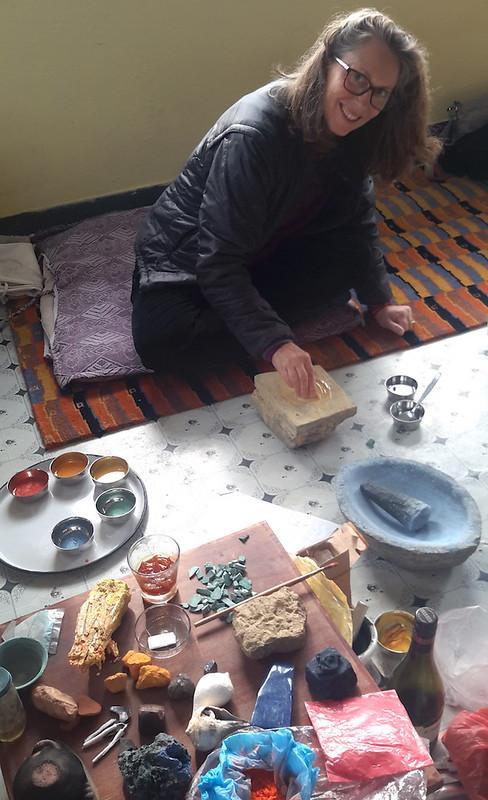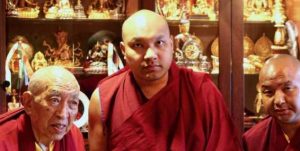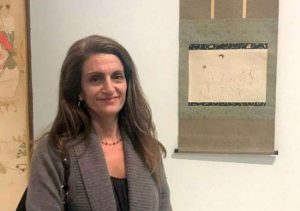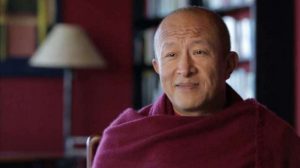
On my first day of learning to work with ground mineral paints, I walked to my teacher’s studio through the labyrinth of narrow streets that wind through the medieval city of Patan in the south-central Kathmandu Valley, and then out of the maze and into more modern city streets, past a street sign featuring a large bronze ear. Well, that’s easy enough, I thought to myself, at least I’ll never get lost: just turn left at the big ear!
My connection with my painting teacher, the renowned artist Sudarshan Suwal, began through his love for my guru, Sri Swami Chetanananda Saraswati, which enabled me to establish a relationship with him via Facebook. Sudarshan has done much work for my ashram, The Movement Center, and two of his works, each of them seven feet square, are primary pieces of art in our meditation room and illustrate the core practices of our tradition: one a painting of Shiva as a cremation-ground-dwelling sadhu and the other an image of Siddhi Lakshmi. These paintings reflect our meditation practice and philosophy, which blends the tantric practices of Kashmir Shaivism with those from the Vajrayana Buddhist tradition. Sudarshan, whose work I have admired for years, is gracious about extending himself to my teacher’s students, and so I had the opportunity to stay on in Nepal to study with him following a pilgrimage to India and Nepal.

Sudarshan is a third-generation thangka painter who learned the art of grinding minerals into paint from his grandfather. His studio, Natural Collection Traders, is in Patan, in the district of Lalitpur, but he was born and grew up on a small street in the heart of Kathmandu nicknamed “Freak Street,” which earned its moniker as the epicenter of the hippie trail in the 1960s and 1970s. As a young man, Sudarshan produced small deity paintings with his father for the tourists that frequented the neighborhood. Sadly, he no longer owns any of those early paintings, although I wish I could see one (if you happen to have one, please do send me a photo!).
Nowadays, Sudarshan is well known and widely respected as an artist, renowned for his vast knowledge of Buddhist and Hindu iconography as well as his prodigious artistic talent. His work has become much more elaborate and refined, and is collected enthusiastically by patrons and museums alike across the world. Sudarshan works exclusively with hand-ground mineral paints, which he and his assistant and brother-in-law Ramesh Ranjit, who is also a master of this technique, grind themselves. The colors yielded by the minerals are brilliant, pure, and bright, yet at the same time soft, pastel, and organic. It’s hard to understand how these pigments can hold such seemingly contradictory qualities without seeing them for oneself. Paints formulated in a laboratory cannot compare.

I have struggled for years to strike these same chords with my thangka paintings by mixing black and white into my gouache paint colors. I think that of all the modern paints available nowadays, gouache paints most closely conjure the feelings I associate with the painted surfaces of antique thangkas—with them you can achieve chalky, dense, rich-yet-soft matte colors. While I feel somewhat satisfied that my end results don’t have the synthetic, sometimes harsh, chemical look of modern paint, nothing compares to real mineral-based pigments—merely reciting their names is a visceral experience—malachite, lapis lazuli, azurite, cinnabar, indigo. . . .
Vibrations don’t only come from a color; they reside in the memory of our collective consciousness of what these minerals look and feel like and how they have been valued over many centuries. Some of these minerals are toxic and so care is required when grinding, but many prepared paints can also be toxic—when a tube of gouache is opened for the first time, it sometimes smells of formaldehyde, which is very carcinogenic. I’ve tried non-toxic packaged mineral paints, but they have their own issues—for instance, the use of honey as a substrate creates a gummy, not-very-fluid painting medium, in my opinion.

Viewing a painting produced entirely with hand-ground mineral pigments is a completely different experience than looking at one made with modern chemical paints. The minerals scintillate and their vibrations seem to extend from the canvas. They have power. Feeling that, the viewer can understand much more succinctly that color is vibration, is energy, and that colors in and of themselves are potent and can be used as healing agents. The sensation of experiencing how they “look” can be compared to thinking about how having a cold “looks”—one might visualize a runny, pink nose and puffy eyes, but you also feel a bit like that as well from the effort. The “look” or visual experience of a painting is just the outermost aspect of the energy that lies within—it’s by the same token that Chinese medicine acknowledges a color for each element and uses color as a healing tool.
I had arranged to meet Sudarshan at Patan Museum where, along with a group of my pilgrimage friends, we meandered through the exhibits. The setting was very beautiful, but the thing I remember most was Sudarshan grinning from ear to ear, saying occasionally: “Ten years friends on Facebook and we finally meet!” I felt like I was connecting with a long-lost brother. After my pilgrimage friends left, I dove right into learning. My first day, sitting in a patch of sunlight on a carpet in Sudarshan’s studio, I began the first step of grinding: placing a shard of stone onto a grinding stone or into a mortar with a little water (or beer for cinnabar) and pulverizing it with a pestle or a chunk of rock. I suddenly understood why such paintings cost a lot of money and realized why they should cost more—the process is very strenuous and time consuming, and somtimes involves handling toxic substances. I learned to mix the minerals with the proper quantity of buffalo-hide glue and then began a small painting to experience all the qualities of each of the paints. While I never did achieve the fine consistency needed to make smooth paint, Sudarshan let me off since my time with him was limited and because, along with painting, he is dedicated to teaching those who want to learn his techniques so that they don’t die out. He wouldn’t have let me off the hook for any other reason!

Ten days was barely enough to receive more than a thimble-full of Sudarshan’s knowledge, but my time with him (and my pilgrimage) undoubtedly changed me and my approach to painting. The most important thing I came away with, with regards to art, from my experiences in India and Nepal is the understanding that surface appearances are not all-important. It may seem a strange thing for a visual artist to say, but while composition and color are important, more so are intention and concentration, the energy and materials one puts into what is painted. Some of the most simple, primitive works of art are the most enigmatic. Love is hidden within intention and concentration, and love is the most powerful force that we have to work with.
Sudarshan’s dedication and his love of his craft are ingrained within his every stroke. His mastery of brushwork and his ability to work with the dense, opaque minerals are obvious when you see the detail in his paintings. A friend of mine likened painting with ground mineral paints to “pushing mud around on canvas.” I would agree. Ground mineral paints are challenging to work with, but ultimately rewarding in what they produce. I think Sudarshan’s passion for mineral paints and for continuing this more-than-700-year-old tradition of the Newari people—the historical inhabitants of the Kathmandu Valley and its environs—are important components of the effect that his art has on the viewer. I am glad of my new knowledge of mineral paints, but even more grateful for the essence within the knowledge that came out of my travels and my work with Sudarshan. I plan on incorporating hand-ground mineral paints into my work alongside my existing techniques, mixing my modern, experimental, self-taught ways with the wisdom of the medieval masters.
Laura Santi is a traditional Buddhist thangka and Hindu deity painter and a member of the Dakini As Art Collective. To learn more about Laura, her work, and Dakini As Art, please visit Dakini As Art.
See more
Laura Santi Sacred Art
Natural Collection Traders
The Movement Center











